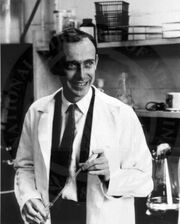Science naturally arises from social human activity. Through the sharing of personal experiences with other members of communities, scientists attempt to escape the limitations of subjective experience and socially construct an understanding of objective reality.

James D. Watson and Francis Crick collaborated from October 1951 to February 1953. Performing no experiments but applying the data of others to their molecular modeling, they discovered the double helix structure of DNA.
Traditional collaboration in science[]
Sharing of observations, results, theories and other forms of information is fundamental to the scientific process. Collaborations are organized and often formalized ways of promoting cooperation between scientists and the sharing of skills and resources.
A spirit of informal collaboration pervades many parts of the general scientific community. Working scientists are aware that they do not know everything and that sharing, cooperation and collaboration are part of the process by which individual scientists increase their personal knowledge and capacity to pursue their scientific goals.
Formal collaborations of different character can be described within the framework of several variable parameters:
- length of duration of the collaboration
- number of people involved in the collaboration
- the range of topics included in the collaborative effort and boundaries that can be placed on the sharing of information and other resources.
One of the most common forms of collaboration is between pairs of scientists, one more senior than the other. In such collaborative relationships, the senior partner often provides resources and a stable working environment while the junior partner does most (if not all) of the hands-on work of observation, experimentation and recording of results. The senior collaborator can often provide useful advice based on past experience with other research projects. The junior partner can sometimes provide new ways of looking at old problems. "Cross-fertilization" between different segments of a scientific community or between typically separated disciplines is often encouraged by forcing young scientists to "migrate" between multiple laboratories over the course of a number of years.
At the other extreme of scale are collaborations between many scientists. "Big science" collaborations such as the Human Genome Project can unite hundreds of scientists in a common goal. However, even in such cases it is not unusual for the larger project to be divided up into subtasks that can each be the special domain of smaller groups or individuals, particular for the purpose of producing publications. However, some large collaborations result in "author" lists on some publications that can number in the dozens and more rarely, the hundreds.

Rosalind Franklin and Maurice Wilkins failed to collaborate while working at King's College London on X-ray diffraction studies of DNA. Although they collected key data that allowed determination of the structure of DNA, it was Watson and Crick in Cambridge who established a fruitful collaboration and discovered the structure of DNA.
Some collaborations are of short duration, maybe just a single experiment. Other collaborations can last an entire career and span several decades. Some collaborations are described as "close" and evolve an intimate sharing of all knowledge and resources. Other collaborations can be much more tangential, possibly only involving the sharing of a very restricted body of information or the results from a particular technical procedure.
The internet and other communication and information processing technologies have provided new ways to accomplish traditional scientific collaborations. Traditional science is very much the product of the Print Age. The goal of traditional collaborations is the generation of scientific results that can be published.
Science collaboration in the wiki age[]
Some electronic technologies provide an opportunity for moving scientific collaboration out of the traditional domain outlined above. Key constraints on traditional scientific collaboration arise from the traditional reliance of modern science on printed text. In general, individuals or research groups "own" the observations and results that scientists obtain and produce. Each scientist or group of collaborators decides on personal or group policies about the sharing of scientific results with the larger scientific community. Some scientists adopt a policy of sharing anything they know with anyone else while others share only what they are forced to put into print in order establish priority and obtain recognition and funding.
Technologies such as the internet and wiki software create the possibility of making all science observations and results "open source". The possibility now exists of movement away from the traditional system of personal ownership of data towards a new way of doing science. Individual scientists can now make all of their observations, results, notes and writings available to the world as soon as they are recorded. There are reasons why cultural momentum will restrain scientists from such "open sourcing" of science, but there are also forces in play that could in the future make open science the new dominant paradigm in science.
Within the old Print Paradigm, publication was expensive. Personal and group records were the raw material for generating publications and had to be guarded and kept secret until they could be converted into publications. In the electronic age, publication is cheap: information can be distributed globally simply by placing it on a webpage. Similarly, in the pre-electronic era, collaboration was often restricted by distance and often involved expensive physical relocation of collaborators. In the electronic age, global networks of collaborators are becoming common.
Some "big science" projects produce more data than can be analyzed by the scientists directly involved. Data bases are increasingly accumulating vast amounts of data that are available for "data mining" by scientists who access data independent of any formal collaborations. New modes of collaboration become possible by which one individual or a group can generate data and other scientists can be given access to the raw data with the agreement that such "outsiders" will establish a formal collaboration if they start to make use of the data. If scientists can still retain "intellectual" ownership of their data in an open environment and get proper attribution for having generated data, then everyone can benefit from open science. Wiki technology can provide instant time-stamping and archiving of collected data and all steps in the analysis of data, establishing priority and allowing for documentation of scientific productivity. Formal peer reviewed publishing can also take place in wiki format[1].
See also science and wikis for today's practical issues related to science wikis.
References[]
- ^ For example, see the publishing system at the Academia wikicity.